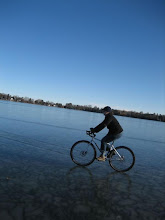So, as some of you know, I am currently in school for a masters in library and information sciences. I decided pretty soon into this program that I would never be able to pull off the naughty librarian look due to a lack of horn-rimmed glasses and a bun, so I have been trying to focus my studies on archival work and public outreach. This area of interest ties in very nicely with my undergraduate and professional background in anthropology, especially in the museum context.
Currently I'm doing a little literature review paper assigned by my archives course professor, and have decided to focus on audiovisual archives and how digitization of these materials is leading towards better ways of allowing indigenous (or at least studied) groups to reclaim their cultural history and dictate how it is used by outsiders.
My readings have lead me to notice major discrepancies between the way we treat indigenous people, or Native Americans/First Nations as they are called in North America, and the way they are treated abroad. There isn't a great wealth of material coming from any other regions than North America and Australia, but in examining the two one quickly notices a marked difference.
In Australia, archivists are working on setting up access terminals in remote areas that are populated by indigenous peoples in order to make ethnographic recordings made of their forebearers accessible to them. These terminals serve many purposes, from helping the living gain access to videos that were shot of their parents and grandparents performing rituals and songs, to helping people of different cultures preserve their native tongues by using such videos and recordings as teaching aids to their young. On a more simplistic level, providing this access restored ownership of their own cultural heritage: recordings that were made of them to further others' academic goals, but were never made available to the actual subjects for their own usage and enjoyment. Another thing that these initiatives are trying to accomplish is a dialog between scientists and those they formerly (and still actively) studied. When different archival files are accessed by an indigenous user, they have the opportunity to give feedback to the scientific community, adding their own tags to an item, or even correcting poor information about locations, individuals appearing in a certain film, or even the significance of what is being shown. In addition to helping scientists learn more about indigenous cultures, the administrators of these digital archives have given the descendants of the individuals involved in these recordings power over who is allowed to use them and how. When a request comes in to an archives to use a recording, it is passed on to the descendants of the participants in said recording; those descendants then have the right to decline the request, or accept it either as is, or on their own terms.
All of this seems very progressive (though not perfect by any means) in my mind, especially when compared to the way similar situations are dealt with here in the U.S.. One example was brought to my attention by accident today when our photo archivist showed me the online database for Anthropology Department at the American Museum of Natural History in New York City. First, I have to say that the design and scope of the database and their website in general is very impressive; they've managed to digitize all kinds of old documents and photographs which help to give people a more accurate idea of what goes on behind the scenes in museums of that nature. However, what I do have a serious issue with is the lack of consideration that the museum has shown about the wishes of the different cultural groups they represent on their site. From my experiences within the anthropology collections at my own museum, I know that many of the objects display in their illustrated database are objects that are forbidden by modern-day descendants to be shown to outsiders or members of certain genders. I won't post any of these pictures to give examples here, out of respect for these wishes, but if one really wants to know what I am talking about, they can look up 'false face masks' of the Iroquois.
On the other side of the coin, The Field Museum, where I work, has been making an effort to work with Native American groups in order to accommodate their wishes in terms of what is and isn't displayed; to date, many Crow and Maori objects have been removed from public display, and work on a new, partially-online and publicly-accessible interdepartmental database is taking into consideration these same standards in place about taboos and display. I'm not trying to toot our own horn because our work here with different ethnic communities is far from perfect, as is the implementation of resulting regulations, but I think at least the beginnings of a dialog are something to be encouraged. Certainly we have a long way to go before we catch up with some of the programs that are in development in Canada and Australia, but it would be nice to see more of our major cultural and governmental institutions making a more serious attempt.
11.09.2007
Owning culture
Posted by
yeahdog
at
10:58 AM
![]()
![]()
Labels: Anthropology, Archives, Audiovisual, Australia, Digitization, First Nations, Indigenous, Museum, Native American
Subscribe to:
Post Comments (Atom)



No comments:
Post a Comment